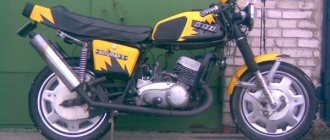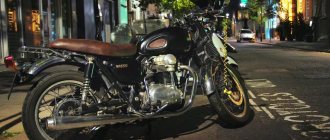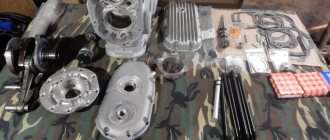This road bike is styled to resemble a retro classic, but there are models that imitate the latter much better. The bike has a long history and is still in demand. The Yamaha CPX 600, like the CPX 400, is a fairly reliable and simple motorcycle, which is why many people love it.
Nowadays it is difficult to find anything similar to this model, which explains its popularity on the secondary market. However, don’t think that a motorcycle is suitable for everyone. This is a purely urban vehicle, that is, it is not particularly suitable for some routes outside the city. Yes, and it is not without specific disadvantages.
Dimensions and weight
Together with fuel, this machine weighs approximately 170 kg. The exact weight will depend on the specific version. The tank capacity does not differ from that of the 400th model and is 15 liters. Like its predecessor in the model range, the SRX 600 has small dimensions: a seat height of 760 mm and a wheelbase of 1425 mm.
Latest posts Popular The most interesting motorcycle news
you are reading the most popular news you are reading all the news you are reading the latest news read the most popular read all the news read the latest news
As a result of all of the above, the Yamaha SRX 600 model was not particularly impressive in dynamics, and in general its design was as simple as possible. Power was supplied by a carburetor, the frame was made of steel, and the transmission had five speeds. A telescopic fork was installed at the front, and two shock absorbers were located at the rear. This bike even had a kickstarter. The latter should be considered an advantage. But the bike did not last long in this form; already in 1991, the second generation of the Yamaha SRX 600 was released in the series, which had a modern appearance, a rear monoshock absorber and the absence of a kickstarter. In general, as you can see, there were no big changes.
In order to accelerate to one hundred kilometers, it will take at least 6.1 seconds, according to the data indicated in his passport, and the highest possible speed is 170 kilometers per hour. True, such “single-barrel” motors are characterized by the disadvantages listed above, which can be noticeable at high speeds, and the Yamaha SRX 600 model was no exception. For this bike, a comfortable cruising speed is about 120 kilometers per hour and six liters of fuel, while reaching a speed of 140 kilometers per hour, eight liters of gasoline are already required. To our great joy, the motorcycle is not particularly demanding on gasoline, and is happily ready to digest any fuel.
Also, the rear suspension of the restyled version of the Yamaha SRX 600, which is more common, can cause doubt. It has the ability to adjust the preload of the monoshock absorber and a free play of only ten centimeters. The 36mm fork, which has a free travel of only 13.4 centimeters, is also difficult to classify as examples of modern technology, even if you take into account the year of manufacture of the motorcycle. Even in the early nineties, more modern models could be found. However, the Yamaha SRX 600 motorcycle was popular with its relatively low cost and reputation as an absolutely indestructible vehicle.
Today, such an iron horse has become very popular among customizers who like to transform this bike into something impressive, since the affordable price and simplicity of the original design contribute to this. At the same time, there are also enough motorcyclists who like this motorcycle in its original form. The arguments in favor include reliability, simplicity and retro style. As arguments against, we should highlight low power, archaic instead of retro styling, sluggish dynamics, weak brakes and indistinct power. However, if this motorcycle had not sold well, then it would not have been able to survive on the assembly line for twelve whole years, right? This means that the Yamaha SRX 600 motorcycle model has its own advantages, which, in principle, we have all listed for you.
Chassis and brakes
The front telescopic fork measures 38 mm. Its stroke is 134 mm, which is quite a lot considering the road class of the motorcycle. The travel of the rear monoshock absorber is only 100 mm. The front brake here is good - it has a 320 mm disc and a single-piston caliper. But the rear disc here is, perhaps, purely symbolic, along with its single-piston caliper.
The appearance as a whole is no worse than that of the four hundredth model. The frame is made of steel, the wheels, although cast, look quite strict and modest, which is good for a road classic. In general, the exterior is typical for a representative of the class of the nineties.
Yamaha SRX 600 motorcycle review
During the season, I managed to drive about 13.5 thousand km, mainly on asphalt, but in completely different modes... for example, I learned that if you cut from Medgora to Petrozavodsk at a speed of 130-150 km/h, then the consumption jumps to 8 liters per 100 km and the oil consumption reaches indecent sizes (which, in principle, is typical for high-speed air-oil single-barreled guns).
and the oil consumption reaches indecent sizes (which, in principle, is typical for high-speed air-oil single-barreled guns). When slightly positive temperatures of +10 and below occurred, the engine was overcooled when driving short distances; the engine simply did not have time to warm up.. in hot weather, although it radiates with heat like a stove, no overheating was noticed, the oil cooler heats up very rarely and only in severe driving around the city.. the chassis, or rather the pendulum of the rear suspension, was not stiff enough, due to the antiquity of the design.. both rear shock absorbers leaked and died - replaced them with a hellish design made from Izhevsk hydraulics, Yamaha springs and ATF220 dextron oil - got a rigid, energy-intensive suspension.. I found out that you can travel to Moscow on a motorcycle in 15 hours)) only this is not a sports tourer and the fifth point makes itself felt after 500 km... in principle, you have to refuel after 200-250 km, at a speed of 100-120 km/h, and there is an opportunity to warm up .. the landing, despite the “sportiness”, is quite comfortable - I’m used to it and forgot about numb hands and butt .. about the landing in general we can say that it is extremely successful and allows you to better feel the motorcycle during maneuvers and the dynamism of the engine for these maneuvers provokes.. but you won’t be able to stand up on the pegs when driving over uneven surfaces, this is not an enduro and the bike is intended for normal asphalt.. although I once climbed into the sands of Ladoga so I had to pull it out with a quad, but this is largely due to the road tires.. the engine allows It’s not a good idea to drive on any surface, be it rocks, sand, grass or dirt... except the chassis is exclusively for asphalt..
When slightly positive temperatures of +10 and below occurred, the engine was overcooled when driving short distances; the engine simply did not have time to warm up.. in hot weather, although it radiates with heat like a stove, no overheating was noticed, the oil cooler heats up very rarely and only in severe driving around the city.. the chassis, or rather the pendulum of the rear suspension, was not stiff enough, due to the antiquity of the design.. both rear shock absorbers leaked and died - replaced them with a hellish design made from Izhevsk hydraulics, Yamaha springs and ATF220 dextron oil - got a rigid, energy-intensive suspension.. I found out that you can travel to Moscow on a motorcycle in 15 hours)) only this is not a sports tourer and the fifth point makes itself felt after 500 km... in principle, you have to refuel after 200-250 km, at a speed of 100-120 km/h, and there is an opportunity to warm up .. the landing, despite the “sportiness”, is quite comfortable - I’m used to it and forgot about numb hands and butt .. about the landing in general we can say that it is extremely successful and allows you to better feel the motorcycle during maneuvers and the dynamism of the engine for these maneuvers provokes.. but you won’t be able to stand up on the pegs when driving over uneven surfaces, this is not an enduro and the bike is intended for normal asphalt.. although I once climbed into the sands of Ladoga so I had to pull it out with a quad, but this is largely due to the road tires.. the engine allows It’s not a good idea to drive on any surface, be it rocks, sand, grass or dirt... except the chassis is exclusively for asphalt..
And now about the spare parts)) At the end of the season, as planned, I took off the engine, the engine was getting old, it began to consume more oil and an inspection was necessary)) upon opening it, I discovered that I was the first to do this, no one had climbed into the engine before me, that I couldn’t help but rejoice , the reason turned out to be what I thought... during many years of parking in a Japanese garbage dump, water got into the engine through open valves, which was the reason for corrosion on the cylinder mirror.. as a result, to replace the ring, the piston, the cylinder was bored well and for decency, gaskets and caps.. The piston of the required size was not available in Europe, I waited a month from Japan.. gaskets, caps, everything else arrived much faster..
, the reason turned out to be what I thought... during many years of parking in a Japanese garbage dump, water got into the engine through open valves, which was the reason for corrosion on the cylinder mirror.. as a result, to replace the ring, the piston, the cylinder was bored well and for decency, gaskets and caps.. The piston of the required size was not available in Europe, I waited a month from Japan.. gaskets, caps, everything else arrived much faster..
Bike of honor! It’s generally ideal for those who are switching from sow cycles! The thrust is like that of a locomotive from almost any speed in any gear, still 600cc on one boiler! Well, what about the reliability of the 2nd season without a single problem, even though the bike was from 1991!!! We should switch to something more serious, but it’s a shame to sell! I'll probably ride again!!!!!!!!!!!!!!!!
Dmitry rode to Crimea and back on his old Yamaha SRX600 motorcycle
Share
Tell
Share
Tweet
Share
This “old man” doesn’t care about any city traffic jams and congestion - he squeezes through even the narrowest cracks. The 1985 Yamaha SRX600 motorcycle has traveled tens of thousands of kilometers with its owner and has a rich history. Once, for the sake of traveling on this bike, its owner Dmitry even had to write a letter of resignation. Now the Yamaha is gathering dust in the garage, and Dmitry has already managed to buy another motorcycle. But the owner is in no hurry to get rid of the rarity. It’s not surprising: look at every detail, because you won’t find such a motorcycle in Petrozavodsk anymore. It even starts with the pedal! Where will you see this now?
Yamaha SRX600 is a Japanese motorcycle that positioned itself as a real men's bike. In the 2000s, he moved to Moscow, and a little later Dmitry bought him. Before this petro was produced in 1973. But one day, having had an accident, I realized that it was time to change the equipment to a newer one with good brakes:
— At that time I worked at STC. For a month and a half I followed my colleague Misha Chuprov and consulted with him on which motorcycle to buy. We settled on this option. There were quite a few of these motorcycles, and all of them, of course, were not in very good condition due to their age. But I liked this bike, and I went to Moscow to get it. The previous owner bought it for no apparent reason. He rode it, fell several times and decided to sell it. That's how I got the Yamaha. I remember the motorcycle ride back well. The SRX was missing the left mirror, brakes and the left remote control did not work. When disassembling the remote control, a bunch of plastic debris and buttons spilled into my palm - the soldering iron came to the rescue. The low beam was on constantly, the turn signals worked, and I covered the hole from the blinker button with electrical tape. I bled the brakes and stirred them up.
The front one somehow came to its senses. The fork was a little snotty with oil, the chain had uneven wear, the tires were cracked, and the air filter was leaking foam rubber. The engine started up disgustingly. I changed the filter and one evening I left Moscow. Having cut 70 km along the Moscow Ring Road, I turned onto Leningradka and drove home. Having reached Zelenograd, I decided to refuel, filled the tank full, and ate a pie. Slowly I sawed further. It was getting dark. I discovered that the headlight was shining into the sky. I parked carefully near the bus stop and turned on the headlight. You can go. Oh, but there is no Kickstarter! My brain is in a panic, I'm terrified. I tried to push start it, no luck. The engine slowly cooled down, it got cold and dark. Well, I think I’ll cool down next... The money on the phone ran out in a panic, I couldn’t call anyone, and I couldn’t call anyone, the house was 1000 km away. He took off his helmet, put it next to the motorcycle and sat down. I lost track of time and my phone battery ran out. A kind mountain resident gave me a bottle of iced tea - I won’t dry out. I was already tired of looking at the noisy stream, I calculated how much it would cost me to get a passing cargo on a truck - there wasn’t enough money, not to mention a gazelle.
Suddenly, with a squeal of rubber, hellish skidding, a minibus stops almost in a ditch. A two-meter hairy guy about 45 years old gets out of there and asks what happened. So and so, I say, I lost the kick. The guy understood everything and opened the back doors. Oops, the Merc is suitable for transporting motorbikes! The guy says: I have a dead motor from a cross-country Husqvarna, it’s very similar, we’ll install a kick from it. Phew, there is hope. But, he says, there are no straps to tie the bike, you sit on it, hold it with your feet. And we rushed off at full speed in the old Mercedes. Then I realized how good it is that the SRX is so light.
We arrived at some garage cooperative and fixed everything. In the morning after breakfast, the guy wished me good luck and waved after me. It's late in the evening. Another 300 km and I'm home. But then I see that there is no light, the battery is dead. I sat down behind the watermelon transport and sniffed its exhaust: driving in complete darkness was dangerous, I was guided by its dimensions. The speed did not exceed 40 km/h, and uphill even 20. Olonets traffic police post. I knew it... they stopped... Well, the conversation came down to a friendly conversation - who, where, where, galloping, galloping, eating and other nonsense. Free, just a little left. The last 200 km flew by unnoticed, I’m home.
During the first season, Dmitry managed to ride a motorcycle about 13.5 thousand kilometers and found out how many hours it takes to get to Moscow without stopping.
— I found out that if you “cut” from Medgora to Petrozavodsk at a speed of 130-150 km/h, then fuel consumption jumps to 8 liters, and oil consumption reaches indecent values. I found out that you can travel to Moscow by motorcycle in 15 hours. Only this is not a sports tourer, and the fifth point makes itself felt after 500 km. In principle, you have to refuel after 200-250 km at a speed of 100-120 km/h, and there is an opportunity to warm up. The landing, despite the “sportiness”, is quite comfortable.
In general, we can say that it is extremely successful and allows you to better feel the motorcycle during maneuvers, and the dynamism of the engine provokes these maneuvers. Only you won’t be able to stand up on the pegs when driving over uneven surfaces; this is not an enduro and the bike is intended for normal asphalt. Although I once climbed into the sands of Ladoga in such a way that I had to pull it out with a quad, but this was largely due to the road tires. The motor allows you to drive leisurely on any surface: be it rocks, sand, grass or soil... only the chassis is exclusively for asphalt.
Since 2007, Dmitry has ridden this motorcycle without knowing any troubles. He reached many Russian cities. True, in order to go on one of the trips, the motorcyclist had to write a letter of resignation. But Dmitry’s vacation was approved, and for three weeks he went to Crimea on a Yamaha, visiting other cities. You have to understand that the bike doesn’t even have a trunk, so with a backpack on his back on a city motorcycle, Dmitry, one might say, signed up for an adventure.
— It took a week to travel to Crimea. I reached Moscow in a day and hung out with friends in the Moscow region for a couple of days. Then I went to Tolyatti and hung out there for a day. Then to Samara, to Saratov. And then in the evening I arrived in Genichesk, went to the market, bought homemade wine and went to the Arabatskaya Strelka to lie on the beach. In the morning I woke up - the waves were splashing, the sea, the sun. I rested there and went back home.
Dmitry bought another motorcycle a long time ago. He says that he wouldn’t go on a trip on an old Yamaha - he’s not the same age. And this bike is intended for city riding, and traveling only around the city is not interesting.
— If you look at the map of Karelia, you can see only two asphalt roads: from St. Petersburg to Murmansk and from Sortavala to Vologda. In such conditions, riding an asphalt motorcycle is not entirely appropriate. Sometimes they ask, ask to sell the Yamaha, but I don’t see the point in that. It's interesting, funny, and easy to use. Nothing broke in it - so be it. And sometimes I let my friends ride it.
As we have already written, the motorcycle does not have an electric start and it starts by pressing the pedal. But this is not the only thing that shows his age. The Yamaha design is typical of the 80s - fewer sharp shapes, smoother details. The motorcycle has only 5 speeds, and the engine was developed for enduro rally bikes that participated in the Dakar.
“What catches your eye here is this kind of Karelian tuning, heated steering wheel grips,” Dmitry laughs. - The rest is hidden inside, it’s unlikely to be of interest to you.
Dmitry says that he has been riding motorcycles since 1998. But the love for bikes appeared long before that.
“As my dad told me, when my mom was pregnant with me, she rode a motorcycle with my dad. Perhaps this somehow affected me and I developed such a craving for bikes. When I was a child, there were a lot of motorcycles on my street, almost every second one in the yard. If a young man did not have this transport, then he was the wrong young man,” Dmitry laughs.
However, Dmitry is unlikely to exchange motorcycle equipment and a bike for a tie and a car. True, there is one vehicle that replaces a motorcycle in winter. And Dmitry promised to show it to us.
— In winter I ride a bicycle, with a motor made in Leningrad. Now it is disassembled, I will show you it in winter in its natural habitat. And so, like everyone else, I end the season in the fall. It’s already not very pleasant to drive: the asphalt is cold and the tires don’t cling to it well, the braking distance increases. There's a little bit of unpredictability.
Dmitry’s motorcycle helmet also has its own history. At first glance, it seems that it has been so well preserved since the 90s. But, as it turned out, his antiquity is just a replica.
— I had a good friend, he died in an accident, who was fond of unusual helmets. He suggested that I order this one from Germany. It is light and comfortable. Its antique design goes well with the Yamaha.










